
| Version | Summary | Created by | Modification | Content Size | Created at | Operation |
|---|---|---|---|---|---|---|
| 1 | Sirius Huang | -- | 7209 | 2022-11-25 01:37:25 |
Video Upload Options
Ynglism (Russian: Инглии́зм, also spelled "Yngliism" or "Inglyism"), institutionally the Ancient Russian Ynglistic Church of the Orthodox Old Believers—Ynglings (Древнерусская Инглиистическая Церковь Православных Староверов—Инглингов, Drevnerusskaya Ingliisticheskaya Tserkov' Pravoslavnykh Staroverov—Inglingov) is a direction of the Slavic Native Faith movement registered with the Ministry of justice of the Russian Federation in the early 1990s by Aleksandr Khinevich from Omsk, in Siberia.({{{1}}}, {{{2}}}) Adepts call themselves "Old Believers-Ynglings", seldom simply "Ynglings". The church is described by scholar Kaarina Aitamurto as having a well-defined doctrine, an authoritative leadership, and focusing on esoteric teachings.({{{1}}}, {{{2}}}) Ynglings regard themselves as perserving the true, orthodox (i.e. in accordance with the universal order), religious tradition of the Russians and of all the Slavs. Rodnover groups in Russia are strongly critical of Ynglism; the international veche (assembly) of Rodnover organisations even declared it a false religion. In the early 2000s the church faced judicial prosecutions for ethnic hatred, and Khinevich himself was imprisoned from 2009 to 2011. The central writings of Ynglism are the four Slavic-Aryan Vedas.
1. Terminology
According to Ynglism history and terminology, the Slavic term for "Orthodox", Pravoslavie (Православие, that like the Greek counterpart precisely means "right glorifying"), which refers to the right way of living in accordance with the universal laws and glorifying the Prav World (World of Gods), was appropriated by the Christian Eastern Orthodox Church among the Slavs only by the 17th century, through the reforms of Patriarch Nikon of Moscow, in order to wholly absorb the indigenous religion which was then still prevalent among the population. Prior to the reform, Christianity used the Greek loanword Ortodoksalnost (Ортодоксальность).[1]
The definition "Old Believers" (Староверы, Starovery), which today is employed to refer to Christians who preserved pre-Nikonian rituals, who are more correctly called the "Old Ritualists" (Старообрядцы, Staroobryadtsy), was imposed on the latter during the same Nikonian reform. Their previous name was "Righteous Christians" (Праведные Христиане, Pravednye Khristiane), and "Old Believers" it itself referred to indigenous Slavic religion. According to the Yngling Church, these theories would be proven by 13th-century documents preserved by a sect of the Christian Old Believers.[1]
In his teachings, Aleksandr Khinevich, the Pater Diy (Патер Дий, meaning "Supreme Priest" or "High Priest") of Ancient Russian Ynglistic Church of the Orthodox Old Believers—Ynglings,[2] does not position Ynglism either as a "paganism", "neopaganism", or as a "religion" at all. This is due to the fact that, as Khinevich say, these words do not reflect the essence of its primary concept.
In this way, the word "paganism" literally means "other faith", and allegedly for this reason Byzantine Christians called Slavs pagans, because for them Slavic Native Faith and culture were foreign. Thereby, «язык» (lat. «lingua», en. «language») is a folk, nation; representative of the folk is «языче» («yazyche»), but representative of another folk is «язычник» (yazychnik (en. "pagan") — "yazyche nikakoi", i.e. literally he's "lingually no-one"). Therefore, pagan is a term only, designating a representative of another faith, culture, language and folk. For this reason, in his words, it is wrong to call oneself a pagan, people can not be a pagan and a foreigner for themselves.
The word "religion" is interpreted by Khinevich differently as well. In his opinion, "religion" is a repeated connection of the higher with the lower, and vice versa, which means that the word is derived from "re" and "league" ("re" — repeating, "league" — union, unification). For example, for some reason people have lost their Faith, and trying to reconnect with their native Gods, to cognize the Ancient Wisdom of their ancestors, and some messenger begins to speak on behalf of God, and they make a doctrine out of these statements. At the same time, it is good if the messenger correctly conveyed the information and understood it properly, and can distort it. Or some wise man begins to explain the faith in his own way, how he himself understands it depending on his education, culture, and creates such a religion. Therefore, there are many religions, these are artificially created teachings, some part of the whole Wisdom ("faith"). But Ynglings' connection with their Gods never stopped, and based on this, Khinevich is convinced that Ynglism is not a religion.
In words of Aleksandr Khinevich, who clearly shares the concepts of the words "religion" and "faith", Ynglism is definitely a faith, since the "faith" ("vera") consists of two ancient Runes:
Veda – Wisdom, Knowledge; Ra – original, primordial Light.
That is, the Faith is the original, primordial Knowledge, that each folk and nation has, i.e. language, culture, traditions, rituals, holidays, information about ancestors (where this folk came from, where its roots are), and the like. This system of knowledge is called in one word — Faith, which is Wisdom, and this knowledge is passed from generation to generation. Therefore, according to Ynglism, each nation and each folk has its own Faith (its own language, traditions, ancestors and knowledges), but some people keep this Knowledge, while the others treat it indifferently: it is – good, it's not – then it is not necessary.
2. Beliefs
2.1. Theology and Cosmology
By the words of Aleksandr Khinevich himself, as "neither monotheistic nor polytheistic" as were the beliefs of the "early ancestors"—the Indo-Europeans, whom Khinevich identifies as the Slavic-Aryans. According to Shnirelman, Yngling theology owes much to Slavic, Germanic, Iranian and Indian sources, but integrates gods and concepts from other cultures as well.[3] The idea of reincarnation matching that of Hinduism, and the idea of a struggle between good and evil forces matching that of Zoroastrianism, are both incorporated within Ynglism. All deities are regarded as the manifestations of a supreme universal God,[4] so that Yngling theology may be defined as monistic. Yngling resources define Ynglism, and Slavic religion overall, as a "rodotheism", that is to say "worship of the gods of the kin", that links back to the supreme God of the universe, which is the universe's supreme ancestor.[5]
Ynglings believe that all these ideas fit the original "Russian spiritual culture" which may rescue people from corruption. Much like other esoteric sciences, they are ambivalent towards Christianity, recognising Jesus as an important prophet (a "great wanderer", veliky putnik) while accusing Christian churches to have distorted his original message, which would be preserved in apocryphal literature. The journal Zhiva-Astra issued by the Yngling Church has published Gnostic scriptures that are popular among Russian nationalists, such as the Secret Gospel of John and the New Testament of the Holy Apostle Thomas discovered in 1945. Ynglings say that early Slavic volkhvs were aware of the concepts of a supreme God and of the trinity, which were later borrowed by Christian organisations. Like other Rodnover groups, Ynglings consider Christianity as an anti-national international machination aimed at the enslavement of people, chiefly Russians.[4]
The highest God and its order
According to Ynglism, "Inglea" (Инглия; cf. the Germanic Yng, Yngwi, whose Scandinavian runic consists in square symbols →, and cf. the Germanic suffix "-ing", implying the action of generation and production) is the Primordial Pure Light (energy), departed from the supreme God, called "Ra-M-Ha" (Ра-М-Ха, also spelled "Ramha") in the Yngling usage. Ra-M-Ha is absolute, unknowable, unfathomable, and yet manifest in the gods generating of all phenomena in accordance with the supreme order, Ingle.[6] This last is personified as the intelligence of God, keeper of the source of the flame of the universe, and is the model of the earliest originator of humanity (Rod).[7] Inglea is represented by the swastika symbol, which Ynglings call the "symbol of Inglea".[8]
Besides the similarity of the names of the Ynglings' Ra-M-Ha and the Indian Rama, it is worthwhile to note that Ramha is identified with the ancient Egyptian concept of Ra central to the other Russian Native Faith practice Vseyasvetnaya gramota.[9]
A hymn to Ra-M-Ha declaims:[6]
-
- Great Ra-M-Ha, the Single Creator, you are in all the Worlds — giver of Life! We are glorify you, all-Natively, from the small to the great, in our Temples and Shrines, on our Hillforts and Churchyards, in our Towns and Hamlets, in our Sacred Groves and Oakeries, ashore our Sacred Rivers and Lakes, for the Holy Inglea, which brings us the Light of Love and Joy, and shines our hearts and thoughts. Let all our deeds, and for Your Glory, now and ever and from Lap to Lap! It was, it is, it will be!
A hymn to Ingle God declaims:[7]
-
- Great Ingle God, Keeper of the Holy Inglea! Be famous! Shine and warm our hearts and souls, our Temples and homes, do not leave without looking at our Kins, now and ever and from Lap to Lap!
The Gods
Primary concepts are the already described absolute God and the matrix into which its gods incarnate—the Earth, characterised as Midgard ("Middle-Realm") in Scandinavian terminology. A third important concept is Rod, who is the archetype of humanity, progenitor of all ancestors. Gods are described as immutable, informational personal laws who harmoniously engender the different forms of life in the universe and support them in their course. They are all in accordance with the order (Yngly) begotten by the supreme God, but at the same time they may exceptionally intervene in the course of phenomena helping people's spiritual evolution along the right path, if people are motivated by sincere creativity and love. An Ynglism dictum is that "the gods are our fathers, and we are their children".[10]
Ynglings distinguish three classes of gods: "Patron Gods" (Боги-Покровители, Bogi-Pokroviteli) are those patronising the celestial bodies, the stars and planets, the Earth, the Moon as well as the "Rods", the progenitors of human lineages (of the bright Aryan "great race"); "Gods-Governors" (Боги-Управители, Bogi-Upraviteli) are those who control various elements, desires, the measured flows of life on Earth; "Gods-Guardians" (Боги-Охранители, Bogi-Okhraniteli) are those who ward various locations on Earth, such as arable lands, forests and the countries of the Aryans. The most important gods from these categories are the "Highest Gods" (Вышние Боги, Vyshniye Bogi): the "Rod-Forefather", Vyshen (Вышень, Slavicised Vishnu), Svarog, Perun, Ramkhat, Matushka, Veles, god-generatrix Mokosh, Chislobog, Dazhbog, Zhiva, god-generatrix Rozhana, Simargl, Kupala, Svetovid, Indra and Kryshen (Крышень, Slavicised Krishna).[10]
"Rod-Forefather" (Род-Породитель, Rod-Poroditel) is the archetype of all the progenitors of the lineages, and is described as one and the same with Ramha, through Yngly. He is without image, like Ramha, but Ynglings worship him through the three-runes symbol of Ramha. His protection flows through Prav, Yav and Nav, the three worlds of traditional Slavic cosmology.[11]
A hymn to Rod-Forefather declaims:[11]
-
- Our Great Rod-Forefather! Hearken to those who call you! Be famous! Since You are the Eternal Source of the life of our Gods and our Kins, and therefore we sing a Great Glory for You, and day and night — we are glorify You, now and ever and from Lap to Lap! It was, it is, it will be!
According to Ynglism cosmology, reality consists of the three dimensions:
- World of Yav (Явь, lit. "actuality") is a physically dense world, which we feel with our senses;
- World of Nav (Тёмная Навь, Навь) is an unfamiliar world, so-called "subtle world". But Ynglings, unlike other Rodnover groups, dividing Nav into Bright Nav – Slav (Светлая Навь, Славь, lit. "glory") and Dark Nav (Тёмная Навь). In Bright Nav our ancestors, but in Dark Nav – demons and other dark beings. Schematically, the Dark Nav is bottom, and the world of Yav is as abroad.
- World of Slav (Светлая Навь, Славь, lit. "glory") is a world of souls and spirits of our ancestors. Bright Nav covers both Astral and Mental Worlds, and world of Prav is over it.
- World of Prav (Правь, lit. "Right") is a world of Gods. It is purely mental. [12]
2.2. The Nine Great Warps
The "Nine Great Warps" (Девять Великих Основ, Devyat' Velikikh Osnov) constitute the ethical code of Ynglism which guides the "weft" of the destiny of the Aryans and their descendants towards perfection. The union of whites and blacks is held to produce wicked mixlings, the "greys"; Abrahamic religions and the masses they persuade are believed to be essentially of a grey nature.[1]
The Warps are:
- Education; "The first warp tells us that we should be cognizing the Scriptures and the Tales, the Wisdom of our Ancestors and the Wisdom of other human Kins. To fill the life with Holiness, and good deeds, for the glory of our Gods and Ancestors."
- Spirituality; "Every human should develop his Spiritual side of the life, and attach to the Spirituality of the other people."
- Compassion; "Everyone should have compassion for all the living beings created by the Gods."
- Placidity (покояние, from the word "покой" — calm); "A human must strive for harmony of his bodies, Soul and Spirit, because only then can he find an inner peace."
- Patience; "A human should treat with understanding to the actions of other humans, because every human is free, but his personal freedom ends where the freedom of another human begins. No personal freedom can be higher than the debt to the Kin and the Celestial Gods."
- Peacefulness; "We must evince peacefulness to all the human Kins, but we shouldn't spare the lives of the enemies that go to our lands with evil thoughts and with weapons."
- Love of neighbor; "We must treat with love and goodness to all the living beings created by the Gods, as well as to the memory of our Ancestors and the History of the human Kins."
- Challenge; "To achieve the Celestial Iriy and the Celestial Asgard, we must walk the path of the Spiritual Advancement. And the trials in our life are to test our Spiritual powers."
- Purposefulness; "Everything in life and life itself has it's meaning, it's purpose, it's task, and every human must strive for his task to fullfill his purpose, and so that his life acquired a Higher Spiritual meaning."[13]
2.3. Views on History
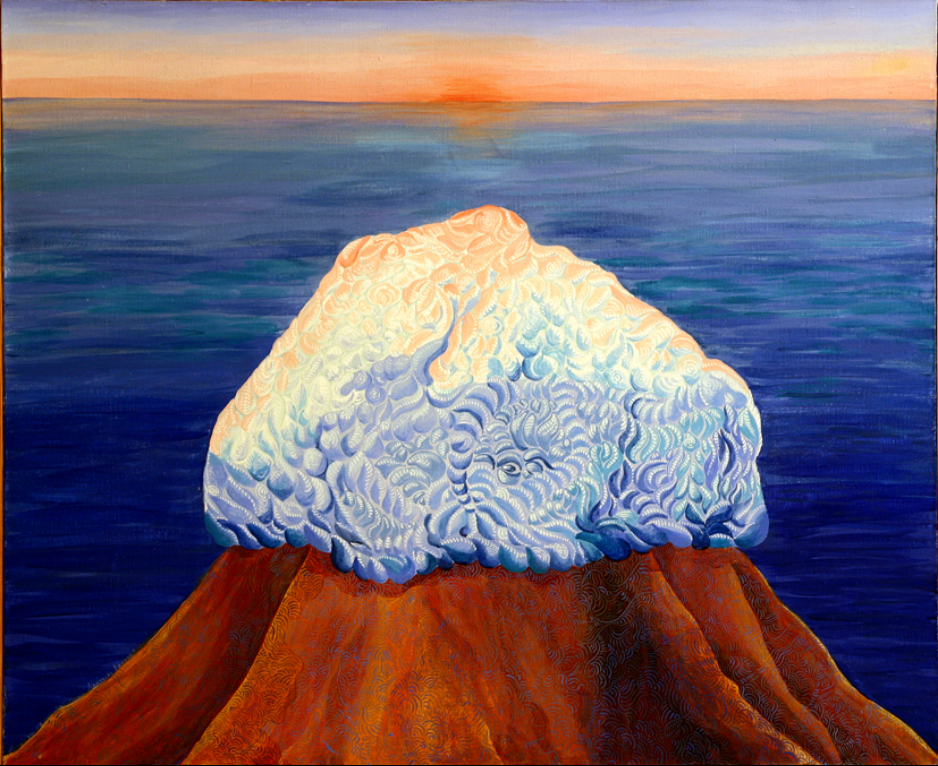
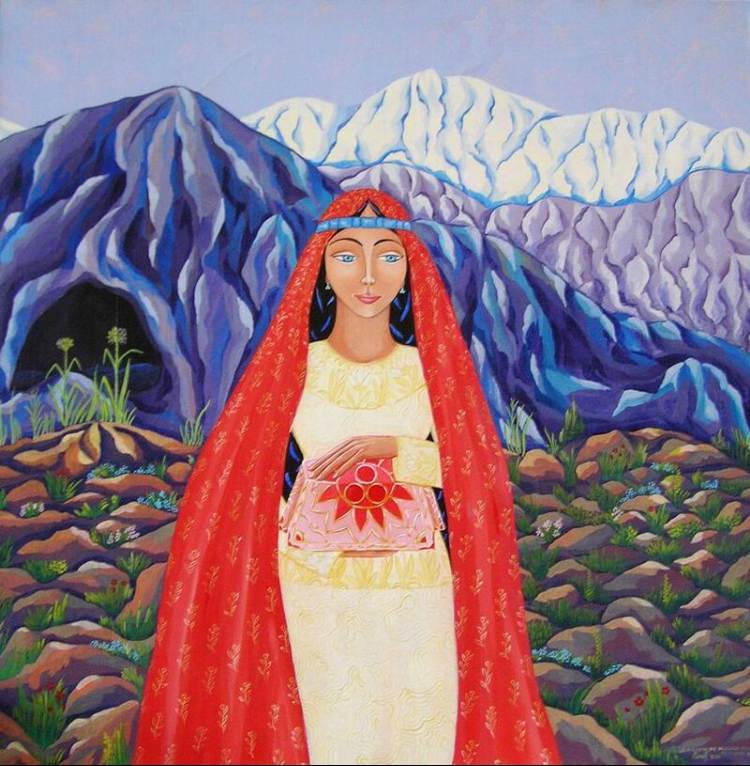
Ynglings believe that "Yngling", a name that identifies the earliest royal dynasties of Scandinavia, means "offspring of Inglea", and that the historical Ynglings migrated to Scandinavia from the region of Omsk, which was a spiritual centre of the early Indo-Europeans. They hold that the Ynglinga saga of the Edda (itself composed by Snorri Sturluson on the basis of an older Ynglingatal), proves their ideas about the origins of the Ynglings in Omsk and is ultimately a more recent version of texts contained in their own sacred books, the Slavo-Aryan Vedas.[14]
Ynglism presents itself as the true spirituality of the Indo-Europeans or Aryans, a term which means "harmonious men", those who act in accordance with the laws of God and therefore manifest bright white features.[13] The first Aryans were spiritually influenced by the northern celestial pole and the circumpolar stars, especially the Great Bear and the Little Bear, and the Big Dipper and Little Dipper astral images; these constellations, spinning umbe the pole, draw the changing image of Yngly (the swastika) in the four phases of the day and the year. The first Aryans dwelt at the geographic North Pole, whence they are known in Greek sources by the name "Hyperboreans" (lit. "over the north"). After leaving their original homeland they mostly settled in what is today Russia and broader Eurasia, where the richest occurrences of hooked cross symbolism in historical testimonies have been found, in patterns of architecture, weaponry, and tools of everyday life. Ynglism would be the means to regather the Aryans and reconnect them to their progenitors, reawakening their pristine way to perceive the world.[13]
The area that Aryans settled once they left the pole was that which in Russian folklore is known as Belovodye (Беловодье, lit. "White Waters"), which Ynglings locate in Siberia and identify as the same as the Tibetan concept Shambhala, the Scandinavian Asgard ("Gods-Realm"), and the land of the Rigvedic rivers: they identify the rivers as the Yenisei and Angara, the Lena, the Irtysh and Ob, and ultimately the Ishim and the Tobol. Architectures were built according to the pattern of Alatyr (Slavic mythological stone or mountain which represents the world centre or the world axle), which is the same as the image of Yngly (hooked cross), which endows human consciousness with virtue.[1]
2.4. Beliefs about Society
Family and politics
The Yngling Church is concerned with the health of the Russians, and other Slavic peoples, and of the family as any folk's fundamental unit. They emphasise that men are innately disposed towards "public" life, while women fulfil themselves in the "private" life of the family at home.[15] Aitamurto (2008) characterises the church as strongly patriarchal; the social model that Ynglism proposes is the traditional hierarchy of the family, headed by male elders. The veche of the church itself is conceived as the gathering of these elders, the fathers. According to Ynglings beliefs, women are "so tied to their natural task of reproduction" that they may not reach the same intellectual and spiritual achievements of men, who are naturally more prone to the abstract thinking that is needed for political assignments.[16]
Ynglism is critical of modern Western liberal democracy, and espouses instead an ideal of democracy that is more similar to ancient Greek democracy. According to the Ynglings, universal suffrage leads to unwise decisions and ultimately to the disruption of society, because the majority of people are not wise. In their view, modern liberal democracies are dictatorships of the "biggest minorities", whereas ancient Slavic veche and mir were based on "consensual decision-making". Ynglings propose the traditional Slavic principle of samoderzhavie, meaning "people ruling themselves", which according to them is the highest "true will of the people" which comes to be incarnated and exercised by a wise ruler.[17]
Education and "beneficial offspring"
According to the church, the demographic decline of contemporary Russia has to be studied as a crisis of the psycho-physical heritage transmitted by Russian parents to their children, and of the environment where these children grow up. Within the Yngling Church, miscegenation is considered as unhealthy, and they also condemn perverted sexuality and the consumption of alcohol and drugs as threats imported from the degenerated West. As a solution, Ynglings emphasise the theme of "creating beneficial descendants" (sozidanie blagodetel'nogo potomstva).[18]
In a broader metaphysical discourse, all forces of globalisation coming from the West are perceived as alien models that infiltrate and spoil the spirit of Slavic culture.
3. Writings
3.1. Slavic-Aryan Vedas
The central sacred writings of the Yngling movement are the Slavic-Aryan Vedas (Славяно-Арийские Веды, Slavyano-Ariyskiye Vedy), purportedly ancient texts,[19] allegedly passed down generation by generation in Siberia. They were allegedly originally written on sheets of precious metal (саньтии, santies), which would be now kept in a secret location by the high priests of Ynglism. Bad translations of the books, misinterpreted through the lens of Western science fiction, have circulated through the Internet.
- First Volume
- Santies Vedas of Perun — Round One (The Book of the Wisdom of Perun), according to Ynglism, are one of the most ancient Slavic-Aryan scriptures, preserved by the Priests-Keepers of the Ancient Russian Ynglistic Church of the Orthodox Old Believers—Ynglings. Santies in the original only visually can be called a book, because of a Santies is a plates of noble non-corrodable metal, on which the ancient h'Aryan runes are inscribed. Ancient runes are not letters or hieroglyphs in the modern understanding. Runes are the secret Images, which transmit a huge amount of the Ancient Knowledges. To imagine what the Santies look like, need to remember that each Santia consists of 16 shlokas, each shloka has 9 rows, in each row under a single line called the "celestial" 16 runes are inscribed, and on each plate 4 shlokas, two on each side. A nine santies on a 36 plates form a Round One, and these plates containing 144 shlokas are bonded by the three rings, which symbolize the three worlds: Yav (World of the living, World of humans), Nav (World of spirits and souls of Ancestors), Prav (World of Slavic-Aryan Gods). A nine Rounds of the Santies containing 1296 shlokas, or 11664 rows, or 186,624 mutual-managing h'Aryan runes, are form a semantic figurative compilation, which is called from ancient times the Veda (lat. Edda). Santies have a meaningful form of dialogue, written down from the words of Perun, and were inscribed about 40,022 years ago. The Round One tells about what precepts Perun God gave to the humans of the Great Race (slavs and aryans), and descendants of the Celestial Kin; about the upcoming events throughout the Svarog Circle and Ninety-Nine Laps of Life, i.e. 40.176 years, and a lot of more.[20]
- Snorri Sturluson. Heimskringla»
- Ynglinga saga is a Norse bright and dramatic, but at the same time very truthful story about the fate of hundreds of people, who really existed in ancient times, but who are the dead for many centuries; a richest gallery of human imageries, drawn with brilliant simplicity. It is a treasury of the preserved information about the distant past of the Northern countries, about its times, about the turbulent epoch of the vikings and other folks.[21]
- Addendum 1. Ynglism — short data». A brief information about Ynglism, as a faith of the Slavic and Aryan folks.
- Addendum 2. Da'Aryan Cislobog's Wheel'. Contains information about the chronology of the Ynglings.
- Addendum 3. Communes and organizations of the Ancient Russian Ynglistic Church of the Orthodox Old Believers—Ynglings.
- Second Volume
- Book of The Light (Charaties of the Light 1-4). Charaties is the parchment sheets made of animal skin, on which the Ancient Runes are inscribed. Charaties of the Light is a mystical ancient scripture of Ynglings' priests, which describes how the universe came into being and how it was born.
- Word of Wisdom of Velimudr the Volkhv. Part 1. It is a compilation of wise sayings by the volkhv Velimudr from the ancient Belovodye.
- Third Volume
- Ynglism. Part 1. A publication describing the generous, but more complete information about the Ynglism as a faith of Slavic and Aryan folks, which was previously unavailable to most readers — Callings and Hymns, Gods, Great Triheads of Worlds, Svarog Circle, Disprensations of Temples and Spiritual Hierarchy.
- Ynglism. Part 2. Birth and upbringing of children, Family Unions, Liturgy and Priests of Ynglism, Sacred numbers of Ynglism, Symbols and Stands of Kins, Symbols in everyday Life (clothes of Slavs, natural oberegs).[20]
- Word of Wisdom of Velimudr the Volkhv. Part 2.
- Fourth Volume
- Source of Life. It is the ancient legend about the ancient world of Images, which turns the modern human into it.
- White Path — about the way of Slavic and Aryan folks.
- Fifth Volume
- Slavic Worldview — Book One. More detailed information about Slavic world perception; confirmation of the Book of the Light.[20]
4. Practices
The spiritual academy "Asgardian spiritual school" of the Yngling Church teaches their version of the Vedas. A main content of the spiritual school courses are:
- Culture and Tradition
- Ancient Languages
- Ancient Russian Language
- Ynglism
- Heritage of the Ancestors. History
- Heritage of the Ancestors. Ancient Vedas
- Theology
- Vedanta — wisdom of the Ancestors (philosophy)
- H'Aryan Arithmetics
- Yujism — world perception of the Ancestors
- Stars and Earths
- Temple service
- Final seminar
The church is known for its "intensive proselytism",[19][22] carried out through a "massive selling" of its books other media. Although, in the example of Aleksandr Khinevich, Ynglings on the contrary not forcing people to anything, and by the nature they are very religiously tolerant. Ynglings organise yearly gatherings (veches) in summer.[23]
4.1. Yujism
Yujism (юджизм, lit. "truth of the earthly world"), also spelled "yudzhism", is the basis of the world perception of Slavs and Aryans. To understand Yujism, need to learn to think figuratively. The image conveys way more information than phonemics, gestures or visual-auditory information.
The world perception is different from the worldview in that it is necessary not only to look at the world, to view it, but also to understand. The one who will understand the structure of Yujism, worldview will be revealed. The one who will not understand it until the end, world perception will be worldview for him.[24]
The first rune of, the aforementioned "image of Inglea" which is the swastika symbol, is conceived as well as the representation of yuj or yudzh (юдж) itself, which Ynglings sources themselves equate with Indian yoga. Yuj is the expansion of human consciousness in both sides, that is triggered by becoming aware of Inglea in reality. Such consciousness articulates into two opposite actions, a positive and a negative one respectively called Ha–Tha (Ха–Тха) and represented by two beams of the swastika. Ynglings claim that they are the ancient Slavic name of the same concept that is known in Chinese thought and language as yin–yang.[24]
The worldview that results from the practice of yujism is symbolised by Ynglings as an image of a "flat earth sustained by three elephants sustained by a turtle which swims in an unlimited ocean": the flat earth represents the twofold structure of perception (articulating in all dualities, from "yes–no" to "up–down"); the three elephants are symbols of the three dimensions of reality — Yav, Nav and Prav — material, ideal (which realises in word) and mystical, which are also three forms of life; the turtle is yuj itself, awakened consciousness, which draws information from the ocean, which represents infinite energy.[25]
4.2. Calendar
Commentaries to the Slavic-Aryan Vedas provide us information about measures of length and time, as well as about the structure of the calendar. The word "calendar" in the opinion of Ynglings comes from a combination of slavic words Koliada and dar (gift). Thereby, literally, "calendar" is a "gift of Koliada". Other designation is a Cislobog's Wheel of Years.
Ceremony of Trizna is customary to spend on the 9th and 40th days, which corresponds to the week and month of the Yngling's calendar.
The main time intervals described in Slavic-Aryan Vedas and its commentaries are:
- Incomplete Fourtie (Month) = 40 days.
- Complete Fourtie (Month) = 41 days. There's a nine forties: Ramhat, Aylet, Beylet, Geylet, Daylet, Elet, Veylet, Haylet, Taylet.
- Week — 9 days. Days are called: monday (ponedelnik), tuesday (vtornik), thirsday (triteynik), fourthday (cetverik), fifthday (pyatnitsa), sixthday (schestitsa), seventhday (sedmitsa), eighthday (osmitsa), and nodsday (nedelya).
- Day was originally divided into 16 hours. According to Ynglism, slavic days begins at 18:00 Gregorian winter time hours, or 19:00 Gregorian summer time hours, because 1,5 billion years ago, ancestors of slavs landed on Midgard-Earth at this time of the day. From this moment, the time report went and it was imprinted in the sayings: "from evening to evening", "long day to evening, when there's nothing to do", "morning of evening wiser", in the evening they saith "here the day has passed", "day and night – days away", that's to say the day goes into the night ‒ day ended with the sunset.[26]
- Hour = 144 parts (= 90 minutes). It is 1½ Gregorian. Each hour has its own name: Paobed (lit. "starting a new day"), Vechir (lit. "evening" or "), Nich (lit. "night"), Polnich (lit. "midnight"), Sautra (lit. "solace of dew"), Saura (lit. "starlight"), Saurnitse (lit. "ending of starlight"), Nastya (lit. "morning dew"), Svaor (lit. "sunrise"), Utros (lit. "soothing of stars"), Poutros (lit. "way of collecting soothed stars"), Obestina (lit. "joint meeting"), Obed (lit. "dinner"), Podani (lit. "rest after dinner"), Utdayni (lit. "time of ending the deeds").
- Part = 1296 shares (= 37,56 seconds).
- Share = 72 moments (1 second = 34,5 shares).
- Moment = 160 sigs (1 second = 1888102,236 instants).
- Sig = 14000 santigs (1 second = 302096358 sigs). 1 sig is approximately equal to 30 oscillations of the electromagnetic wave of the cesium atom, taken as a basis for modern atomic clocks.[27]
Every year has a 9 forties (months) and consists of three natural seasons: Autumn, Winter and Spring. That is, for each natural season there are three forties. A year can be of two types:
- Simple year = 365 days, in which all the uneven forties (months) consists of 41 days, and even forties is of 40 days. (5х41=205)+(4х40=160)=365.
- Holy year = 369 days. In this year, 9 months are last 41 days. Holy year repeats every 16 years. (9x41)=369.
Letos are grouped into:
- Lap of years = 16 years. It consists of 15 Simple years and one Holy year.
- Lap of life = 144 years. It consists of 9 Laps of years (16x9=144).
- Eternal year = 256 years. It consists of 16 Laps of years (16x16=256). Only one mention in the texts of Slavic-Aryan Vedas.
- Star hall — 1620 лет. A time interval, during which the sun rises in a certain star hall. It unites 16 halls (constellations) located along the visible annual path of the Sun among the stars.
- Svarog Circle = 25920 years. It consists of 180 Laps of life (144x180=25920). The period of full rotation of the star halls of starry sky which observed from the Earth. Throughout the Svarog Circle, the Sun moves in the skies from hall to hall (from constellation to constellation) in the opposite direction from the normal annual cycle. The point of sunrise at the autumn equinox shifts annually and for every 1620 years passes to the next star hall (1620x16=25920), counting down the epochs.Every fourth hall coincides with every third zodiac constellation, thus, in 2012 came the epoch of the Wolf (White Dog[28]), which corresponds to the era of Aquarius in classical astrology. This refers to the precession.
| № | Name of hall, epoch | Patron God | Date of an epoch | Day |
|---|---|---|---|---|
| 1 | Virgin | Jiva | 10948–9328 B.C. | Twilight |
| 2 | Ras (White Leopard) | Dazhdbog | 9328—7708 B.C. | Twilight |
| 3 | Eagle | Perun | 7708–6088 B.C. | Twilight |
| 4 | Horse | Kupala | 6088–4468 B.C. | Night |
| 5 | Phinist (Phoenix) | Vyshen | 4468–2848 B.C. | Night |
| 6 | Elk | Lada | 2848–1228 B.C. | Night |
| 7 | Ox | Kryshen | 1228–392 B.C. | Night |
| 8 | Fox | Mara | 392–2012 A.D. | Night |
| 9 | Wolf (White Dog) | Veles | 2012–3632 A.D. | Dawn |
| 10 | Busel (Stork) | Rod-Forefather | 3632–5252 A.D. | Dawn |
| 11 | Bear | Svarog | 5252–6872 A.D. | Dawn |
| 12 | Raven | Kolyada, Varuna | 6872–8492 A.D. | Dawn |
| 13 | Serpent | Simargl | 8492—10112 A.D. | Day |
| 14 | Swan | Mokosh | 10112–11732 A.D. | Day |
| 15 | Pike | Rozana | 11732–13352 A.D. | Day |
| 16 | Veper (Boar) | Ramhat | 13352–14972 A.D. | Day |
Below is the list of some of the more important "dates of the past", as of 2018, according to the Slavic-Aryan Vedas:
- Year ~1,5 billionth from the Arrival of the first Vytmara to Midgard of the Great Race and the Celestial Kin (~1,5 bn. BC);
- Year 957 527 from the Appearance of the Gods (955508 BC);
- Year 604 393 from the Time of the Three Suns (602 374 BC), described as an astronomical event of the convergence of the system of Yarilo-Sun with the orbits of two white giants, resulting in two of the nearest stars being visible in the sky of the Earth as clearly as the Sun;
- Year 460 537 from the Time of d'Arra (458 518 BC);
- Year 273 913 from the Time of h'Arra (271 894 BC);
- Year 211 705 from the Time of Swaga (209 686 BC);
- Year 185 785 from the Time of Thule (183 766 BC);
- Year 165 049 from the Time of Tara (163 030 BC);
- Year 153 385 from the Assa of the Dea (151 336 BC) — the grand war with the Dark forces from Peklo (lit. "Hell", which is lenticular galaxy, in which life only begins), which resulted in the moon of the planet of the Dea (i.e Planet V) — Letitia (Lucifer) — being destroyed, thus formeing the asteroid belt.
- Year 143 009 from the Time of the Three Moons (Lelia, Fattah and Mesiats) (140 990 BC);
- Year 111 825 from the Great resettlement from the Daaria (109 806 BC);
- Year 106 797 from the Foundation of the Irian Asgard (Taylet 9 (20 August) 104 778 BC);
- Year 103 773 from the Building of the Gates of the Interworld in the Altai (started in 101 752 BC to 101 698 BC, it was built for 54 years).
- Year 44 563 from the Creation of the Great Lap of Racenia (42 544 BC);
- Year 40 023 from the Third Arrival, of the Vytmana of Perun (38 004 BC), after which, according to the Ynglism, the Santies Vedas of Perun were written;
- Year 13 027 from the Great Frost (11 008 BC), in science defined by concepts such as glaciation or ice age. This is interpretted as a result of the destruction of one of the two remaining moons of Earth in the epoch, Fattah, of which a big fragment impacted the area of the Pacific ocean. This caused large tectonic and volcanic activity around the planet, causing the atmosphere to be contaminated. As interpreted by the Ynglings, it threw people into the "stone age";
- Year 7 527 from the Conclusion of Peace in the Star Temple (5 508 BC). This is the peace treaty between the Great Race (Slavs and Aryans, i.e. the white race) and the Great Dragon (ancient Chinese or arims, as they were called by in that time, i.e. the yellow-skinned people) was concluded on the day of the Autumn Equinox or on the 1st day of the first Fourtie (Ramhat) of the year 5500 from the Great Frost. The victory was won by the Great Race, which was symbolically displayed in the form of an image of a white knight on a horse striking a dragon with a spear (Moscow coat);

Structure of the year
Ynglism has a different structure in comparison with Rodnovery. According to Ynglism teachings, Ynglings month's names may be written as a compound of two Ynglings runes. The names of the months always consist of two Runes, and the second Rune of all the months is the same –Let (Летъ), which means "year" as well as "summer" (as months are phases of the year which comes to full maturity in summer), because of the month is a part of the Year; and the first Rune shows the image, which exactly the part of the Year it is. The only exception is the first month whose name is "Ramhat" (Рамхатъ), because it is image of the Beginning of a new Lap. Thereby, after the completion of another Year, we come to the beginning of everything again — RA-M-Ha, who claims (T) and creates (Ъ) a new Lap, as the beginning of a new Life.[29]
| Name | Runic sign | Meaning | Corresponding Latinate month(s) |
|---|---|---|---|
| Ramhat Рамхатъ |
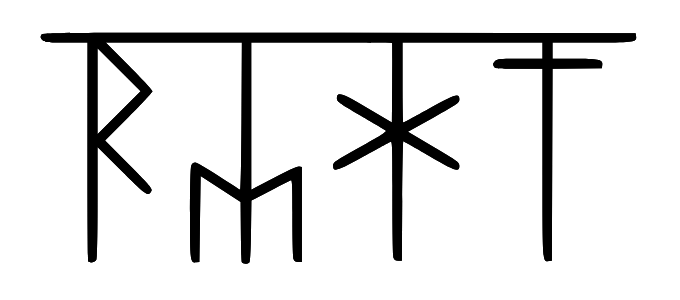  |
It is the month representing the Divine Origin; Ra-M-Ha posited and created a new year cycle.[29] Another rune of this month is a swastika-like, which is the symbol of Inglea itself (the divine life-giving fire of creation)[8] | September–October |
| Aylet Айлетъ |
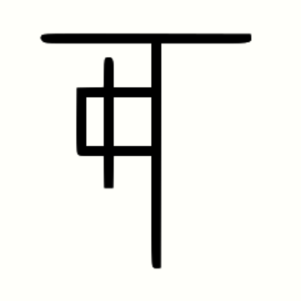 |
Aylet is the month of a New Gifts. Within this context, rune Ay means an entire abundance, prosperity, full baskets. By this time people have harvested their crops, celebrated a wedding on Lubomir, met the Novoletie, built a separate house for the newly married couple with outbuildings. Thereby, a new life starts from the full abundance, from the gifts, from the household with the cattle, from everything.[29] | November–December |
| Beylet Бэйлетъ |
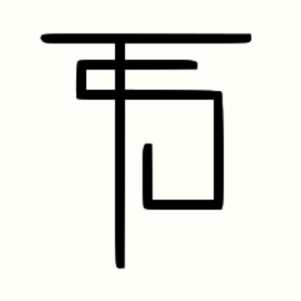 |
Beylet is the month of the White Shining and the Calm of the World; it's a white part of the year. It's a radiance of the world of Slav, divine level of purity, a feeling of the entire peace in the Soul.[29] | December–January |
| Geylet Гэйлетъ |
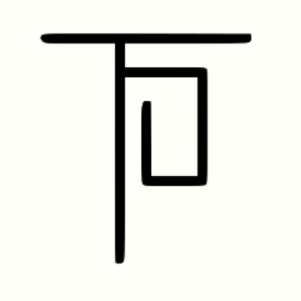 |
Geylet is the month of the Blizzards and Icy Cold. Rune Gey means fierce, severe.[29] | January–February |
| Daylet Дайлетъ |
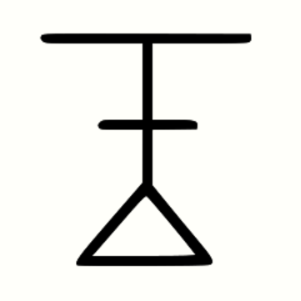 |
Daylet is the month of the Awakening of the Nature. Thus, it's a part of the Year when the Nature gives vitality: leaves grow, fields are filled with the power, animals waking up, anything is awakened, revived, alive.[29] | March |
| Elet Элетъ |
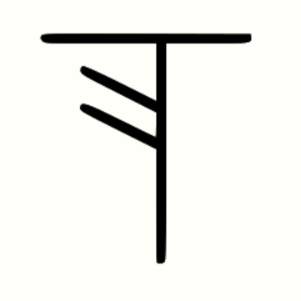 |
Elet is the moth of the sowing and naming. Image of the rune Gey is the blizzard, severe cold, but the blizzard sows by a snow, ice particles, heavy snowfalls and the like, i.e. image is the sowing. While the rune E is just sowing, with no cold. But the sowing not only of grain in the land, but the word into human, i.e. the rite of Nametaking, when a human is given a new, secret name.[29] | April |
| Veylet Вэйлетъ |
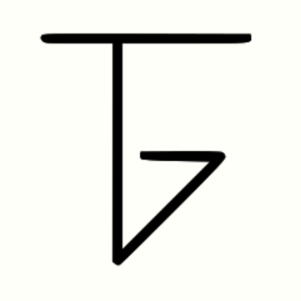 |
Veylet is the month of the winds. Image of the rune Vey is the blow, and the wind blows. Thus, it's a part of the Year when the Stribog's grandsons wake up and begin to walk, often hurricanes, dry winds.[29] | May–June |
| Heylet Хейлетъ |
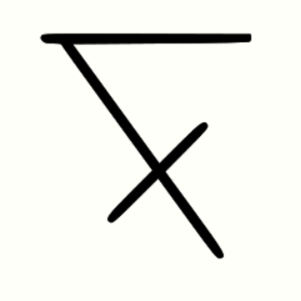 |
Heylet is the month of the Taking of the Gifts of Nature. The image of "H" is a positive force.[29] | July |
| Taylet Тайлетъ |
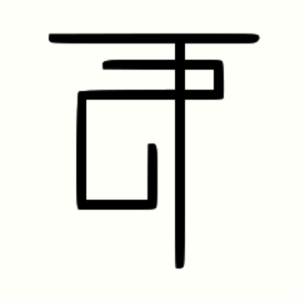 |
Taylet is the month of the Completion of the Year. The rune Tay means the top, the border, the completion of something. For example, the word "Taiga" literally means "the end of the path".[29] | August–September |
Kologod
According to Ynglism, a Kologod ("kolo" — circle or lap, "god" — year) is a system of rituals and holidays that helps a human to stay in harmony with nature throughout the year. 8 basics of the Kologod are Gods, or the laws of the nature. Between the global transitions there's also a meeting (sreche) - autumnal, spring, wintery; and between it a 3 more small meetings. Below are the main holidays of the Ynglings - global transitions.[30]
| Festival | Meaning | Period |
|---|---|---|
| Kolyada | Sun's birthday (winter solstice). This is a global turn, transition, rebirth of everything.This is a global turn, transition, rebirth of everything. It is the only times when nature gives a human the opportunity to get rid of diseases, curses, to start all over again. Since this is time of men, they are given from the top (ancestors' help) different tips, ideas, how to organize a year.
Kologod ("Kolo" — wheel, sun) is our Alatyr — eight-pointed star, which is carried by koledaries. This star is multi-colored, symbolizes all Gods of Ynglings, and all the laws, and all this spectrum is given to people from the beginning. Spins the Alatyr is by spiral posolon (thus is, clockwise), and human should live by kologod so that on each new round he go out with a new spiral (had children, planted a tree, did a thesis, wrote a book, e t.c.). As soon as a human stops thinking and developing, he begins to go in the opposite direction and comes to the point of death.[30] |
December |
| Veles | Ecologically wise program. Veles is an image — the Laws of Nature. He's the God of the Wisdom, wildlife, underworld... Thus is, all starts with the underworld, which we must take care not to violate the ecology. Then the fertile soil layer on which plants grow – food for birds, animals and humans. Human uses all this and must act wisely with the environment, to comply with the Laws of Nature. The period from Kolyada to Veles is the time bookmarks of new deeds. At this time, humans concluding a contract, choosing a shepherd, making new plans, and so on, because of nature works like that and the human head works like that. As long as the sun is weak, people make responsible decisions for the future.[30] | February |
| Lelia | Divine sparks between a young man and a young girl. Spring equinox, a time when the men and women vigors are aligned by nature.The sun flares up, nature blossoms, people's hormonal system begin to work very actively, blood liquefies, it is time for love. On Lelia drive a two dance toward each other: posolon is men's, women's is osolon. Energy is transmitted through the eyes and hands, so there are no sudden movements in the round dance, everyone is looking for balance, there is an exchange of energy, who gives it a lot, who takes little. There's a harmony in the whole hamlet.[30] | March–April |
| Yarilo | A sexual potency. In nature, everything begins to brighten, all the ardent - sprouts, petals, and a flowers, and a humans should bright (in Slavic this procedure is called brighting). Yarilo's merrymaking and fairs are arranging. On Yarilo is happening very strong insight, clairvoyance. Yarilo – a preparation for Kupalo.[30] | May–early June |
| Kupalo | A peak of powers. On the Kupala is the brightest sun, almost never coming down, male and female coincided. The whole nature glows, gaining maximum strength, and people have the fire inflames, and is equal in men and women. Therefore, on the Kupala people are tried to conceive children in the daytime, and in the fields, not in bed. On March 26, half of the village's children were born, and people were said - Kupala child, a healthy child. A roundelay on the Kupala is lead one common.[30] | July |
| Perun | The initiation of menfolk. On the day of Perun men showed their skills and abilities in handling weapons, their strength, the boys undergo the rite of passage in menfolk. Since that time, in men begin a sharp drop in hormone, they go to travel, they need to change the activity, relax (hunting, fishing), and women in blossom: conceived the children on the Kupala, if was not conceived, just gained a strength.[30] | August |
| Mokosh | A self-analysis. Mokosh is the Goddess of the fate. The year ends, and at this time for a human the most important thing is to conduct a self-analysis, to realize what he did in the outgoing year, what were the mistakes. Only after a self-analysis and realizing the mistakes, human can be transformed and go to the next round of the spiral. Rite on the Makosh — to go into the field, take a handful of earth, to remember what was good and bad in the outgoing year, put the ground; next, take the following handful of soil, e t.c. After analyzing the outgoing year, resulting in the slide to rake the middle and light a small fire or light a candle. With this "fire of fate" burns everything that happened. Thus, the human conducted a self-examination, he did not go to church to kiss yid's hand, so that his sins were released, but he realized his mistakes himself – this is the most difficult thing, to check and change yourself.[30] | September–October |
| Mara | The cognizing of the Ancient Wisdom. On the Mara, the Sun dies, it is the shortest days, ultraviolet light is very weak and small, so the biochemical composition is another, the blood is another, hormonal system is declined, in sensitive people is depression. At this time, the head works well, so human need to purposefully read myths, fairy tales, epics. On the Mara, the corresponding channel opens and a human can realize in long-known fairy tales what did not notice earlier, receive Godly knowledge. And how he will gain something, it will become clear to imagine, and this will be included in the next Kologod.[30] | November |
5. Social Impact
5.1. Links with Political Parties
Aitamurto (2016) characterises the Yngling Church as less politically goal-oriented than Rodnover movements.[23] By contrast, Russian scholar of religion Vladimir B. Yashin of the Department of Theology and World Cultures of Omsk State University wrote in 2001 that the church has close ties with the regional branch of the far-right Russian National Unity of Alexander Barkashov, whose members provide security and order during the mass gatherings of the Ynglings.[2]
5.2. Judicial Prosecutions and International Spread
The headquarters of the Yngling Church were prosecuted and liquidated by law between 2002 (in the Omsk region) and 2004 (in Russia), primarily because of its use of swastika-like religious symbolism and because of its teachings about the unhealthiness of interracial mixing. Aleksandr Khivevich himself was prosecuted on 11 June 2009 at the International Court of Justice of Omsk, which found him guilty of inciting racial hatred under the article 282 of the Criminal Code of the Russian Federation and sentenced him to one year and a half of prison with two years of probation.[2][23]
Despite the prosecutions, the church continued its activities and mass celebrations as an unregistered religious movement, expanding to other regions of Russia and abroad, and Aleksandr Khinevich resumed large-scale preaching activities in 2011. Scholar Vladimir Yashin reports that it was impossible to uproot the church from public life, since in 2001 there were already about three thousand members in Omsk alone.[2]
According to Yashin, Ynglism has come out strengthened from the prosecutions, turning into a decentralised phenomenon, so that as of 2015 it is more correct to describe it as a movement of dozens of organisations spread between the regions of Chelyabinsk, Krasnodar, Tyumen, Moscow, but also Ukraine , Germany and the Czech Republic. Ynglism, together with mainstream Rodnovery, has gathered many adherents in the North Caucasus regions, according to Yashin as a Slavic-identity counterweight against Islam. In 2015 it was the turn of the Slavo-Aryan Vedas, the sacred writings of Ynglism, to be condemned as "extremist literature" in Omsk.[2] In the same year, Yngling communities based in Stavropol were prosecuted on the charge of extremism.[31]
References
- "Belovodye – the ancestral home of Aryans and Slavs (Беловодье – древняя прародина Ариев и Славян)". http://derzhavarus.ru/belovodje-prarodina-ariev-slavyan.html.
- Maltsev, V. A. (18 November 2015). "Расизм во имя Перуна поставили вне закона". http://www.ng.ru/ng_religii/2015-11-18/3_perun.html. Retrieved 3 July 2017.
- Shnirelman 2017, p. 97.
- Shnirelman 2017, p. 98.
- "Rodotheism – the veneration of the Kin (Родотеизм – это почитание Рода)". http://derzhavarus.ru/rodoteizm-pochitanie-roda.html.
- "Ramha (Рамха)". http://derzhavarus.ru/ra-m-ha.html.
- "God Yngly (Бог Инглъ)". http://derzhavarus.ru/bog-ingl.html.
- "Ynglism – lesson 1 (Инглиизм – урок 1)". http://derzhavarus.ru/ingliizm-urok-1.html.
- Aitamurto 2016, p. 41.
- "Highest Gods (Вышние Боги)". http://derzhavarus.ru/bogi.
- "Rod-Forefather (Род-Породитель)". http://derzhavarus.ru/rod-poroditel.html.
- "Yav, Nav, Slav, Prav (Явь, Навь, Славь, Правь)". http://derzhavarus.ru/jav-nav-slav-prav.html.
- "Ynglism – Ancient Faith of the Slavic and Aryan Peoples (Инглиизм – Древняя Вера Славянских и Арийских Народов)". http://derzhavarus.ru/ingliizm-vera-slavyan-ariev.html.
- Aitamurto 2016, pp. 50–51.
- Aitamurto 2016, p. 86.
- Aitamurto 2008, p. 4.
- Aitamurto 2008, p. 5.
- Aitamurto 2016, p. 88.
- Aitamurto 2007.
- "Славяно-Арийские Веды — читать онлайн — Держава Русь". 2016-08-28. http://web.archive.org/web/20160828234030/http://derzhavarus.ru:80/slavyano-arijskie-vedy.
- Славяно-Арийские Веды. Книга Первая, «Снорри Стурлусон. Круг Земной», предисловие
- Gennadevich, Kuzmin Aleksandr (2014). "Неоязыческая печать в современной России: особенности идеологии и пропагандистской деятельности (Neo-Pagan Press in Modern Russia: Specifics of Ideology and Propagandistic Activity)". Грамота (Gramota). 12 (50) pp. 121-124. ISSN 1997-292X. Abstract: «The article is devoted to the analysis of the publishing and propagandistic activity of the modern Russian neo-paganism in the structure of national patriotic movement. The paper assesses the level of the radicalism of the ideas propagated by the analyzed publications. Special attention is paid to the propagandistic and publishing activity of the ideologists of the so-called Ynglism.» http://scjournal.ru/articles/issn_1997-292X_2014_12-1_29.pdf
- Aitamurto 2016, p. 51.
- "Yujism – world perception of slavs (Юджизм – мировосприятие славян)". http://derzhavarus.ru/judzhizm-mirovospriyatie.html.
- "Earth on three elephants (Земля на трёх слонах)". http://derzhavarus.ru/ploskaya-zemlya-3-slona-cherepaha.html.
- Omel. "Славяно-Арийский Календарь" (in ru). http://energodar.net/ha-tha.php?str=vedy/kalendar.
- Omel. "Славяно-Арийский Календарь" (in ru). http://energodar.net/ha-tha.php?str=vedy/kalendar.
- Славяно-Арийские Веды. Книга Первая, «Саньтии Веды Перуна — Круг Первый», Сантия 6, стих 12(92)
- "Slavic names of the months (Славянские названия месяцев)". http://derzhavarus.ru/slavyanskie-nazvaniya-mesyacev.html.
- "Кологод — природосообразность (Kologod – accordance with nature)". http://derzhavarus.ru/kologod-prirodosoobraznost.html.
- "Racism and Xenophobia in October 2015". 9 November 2015. http://www.sova-center.ru/en/xenophobia/news-releases/2015/11/d33204/. Retrieved 3 July 2017.




